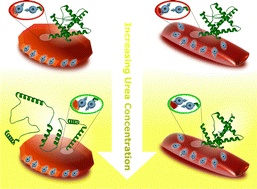The effect of spin exchange interaction on protein structural stability†
Abstract
Partially charged chiral molecules act as spin filters, with preference for electron transport toward one type of spin (“up” or “down”), depending on their handedness. This effect is named the chiral induced spin selectivity (CISS) effect. A consequence of this phenomenon is spin polarization concomitant with electric polarization in chiral molecules. These findings were shown by adsorbing chiral molecules on magnetic surfaces and investigating the spin-exchange interaction between the surface and the chiral molecule. This field of study was developed using artificial chiral molecules. Here we used such magnetic surfaces to explore the importance of the intrinsic chiral properties of proteins in determining their stability. First, proteins were adsorbed on paramagnetic and ferromagnetic nanoparticles in a solution, and subsequently urea was gradually added to induce unfolding. The structural stability of proteins was assessed using two methods: bioluminescence measurements used to monitor the activity of the Luciferase enzyme, and fast spectroscopy detecting the distance between two chromophores implanted at the termini of a Barnase core. We found that interactions with magnetic materials altered the structural and functional resilience of the natively folded proteins, affecting their behavior under varying mild denaturing conditions. Minor structural disturbances at low urea concentrations were impeded in association with paramagnetic nanoparticles, whereas at higher urea concentrations, major structural deformation was hindered in association with ferromagnetic nanoparticles. These effects were attributed to spin exchange interactions due to differences in the magnetic imprinting properties of each type of nanoparticle. Additional measurements of proteins on macroscopic magnetic surfaces support this conclusion. The results imply a link between internal spin exchange interactions in a folded protein and its structural and functional integrity on magnetic surfaces. Together with the accumulating knowledge on CISS, our findings suggest that chirality and spin exchange interactions should be considered as additional factors governing protein structures.



 Please wait while we load your content...
Please wait while we load your content...